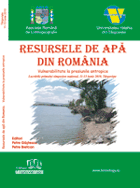11-13 June 2010. Water resources from Romania. Vulnerability to the pressure of man’s activities, Targoviste (Romania)

Resursele de apă din România. Vulnerabilitate la activităţile antropice
[Water resources from Romania. Vulnerability to the pressure of man’s activities]
Conference Proceedings
ISBN: 978-606-8042-65-7
11-13 June 2010, Targoviste - Romania
Editors
Petre Gâştescu
Petre Breţcan
EFECTE ALE FENOMENELOR HIDROLOGICE EXTREME PE DUNĂRE- SECTORUL CĂLĂRAŞI –HÂRŞOVA DIN ANII 2003 ŞI 2006
Marius Marian Spahiu1, Narcizia Ştefan2, Lidia Sălăjan3
1Şcoala Generala nr. 4 Feteşti, 2 Facultatea de Geografie Bucureşti, 3INHGA Bucureşti
Şoseaua Bucureşti-Ploieşti, nr. 97, Sector 1, Bucureşti,
email: lidia.salajan@yahoo.com
EFFECTS OF EXTREME HYDROLOGICAL PHENOMENA ON THE DANUBE RIVER – CALARASI-HARSOVA SECTOR BETWEEN 2003 AND 2006
Abstract. The first part of the paper presents a short geomorphologic characterization of the Calarasi-Harsova sector, which is an integrated part of the Eastern Romanian Plain fundament, as well as its morphometric characteristics. From the hydrological point of view, the Danube River splits into two branches in this sector: eastwards Dunarii Vechi Branch and westwards Borcea Branch. The minimum flow from 2003 was characterized by the lowest discharges in the last 100 years, caused by a prolonged drought which was due to an air mass of African origin which was stationary over Europe. The extremely low values of levels and discharges from July-September 2003 determined the shutting-down of the Nuclear Reactor from Cernavoda. It affected the national energetic system with a negative influence on the economy. The variation of annual levels and discharges was analyzed on the Calarasi-Harsova sector from 2003 and the lack of the flow regime of the flood from the spring-summer period was observed. The maximum flow from 2006 caused important discharge increase at the entrance in the country on the Danube River (Buzias sector) and downstream the Portile de Fier sector, determining the recording of historic discharges with return period of over 100 years. In order to avoid the flooding the downstream towns, controlled breaches were executed in the Facaieni section on the Borcea Branch and Calarasi – Raul and the collapse of the dyke from Oltina on the Dunarea Veche Branch. The analysis of annual levels and discharges from this sector and the characterization of the flow regime from 2006 were performed. At the and of the paper, the estimation of the flood effects on the Danube River from 2006 on the Calarasi-Harsova sector was performed emphasizing the solution proposed for the reconstruction of the analyzed sector and the works made up to now.
© Asociatia Romana de Limnogeografie (2008)

